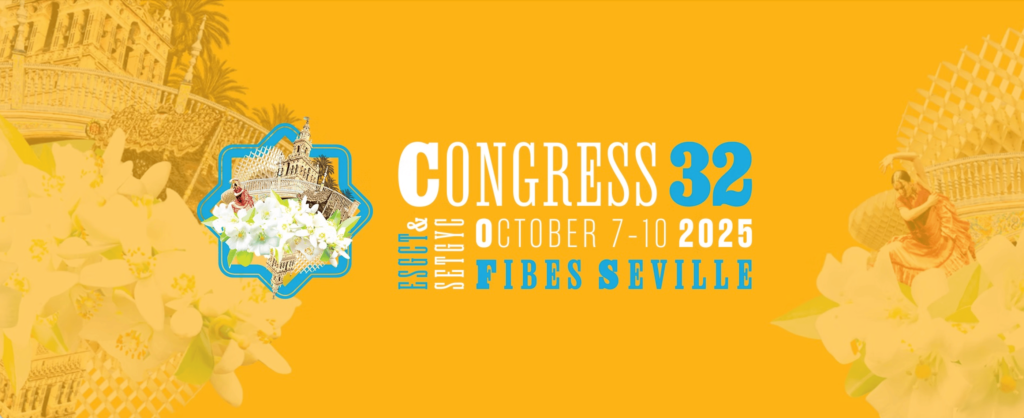ESGCT 2025 : les dernières recherches de 19 scientifiques de Généthon mises à l’honneur !
À l’occasion du 32e congrès annuel de l’European Society of Gene and Cell Therapy (ESGCT), qui se tiendra du 7 au 10 octobre 2025 à Séville, les équipes de Généthon seront une nouvelle fois mises à l’honneur. Ce rendez-vous international majeur réunira les plus grands experts de la thérapie génique.

23 communications scientifiques, dont 4 présentations orales
Cette année, 19 chercheurs et experts de Généthon présenteront leurs travaux lors de l’ESGCT 2025, à travers 4 présentations orales et 19 posters. Ces contributions illustrent la richesse et l’excellence de la recherche menée par Généthon, pour faire avancer la recherche et mettre au point des thérapies innovantes pour traiter les maladies rares d’origine génétique.
« Participer au congrès de l’ESGCT est une opportunité unique pour nos équipes de partager les derniers résultats de nos travaux. Ces avancées scientifiques et médicales peuvent changer la vie des patients. Les présentations orales et posters sélectionnés reflètent non seulement l’expertise de nos équipes, mais aussi le rôle pionnier et leader reconnu de Généthon dans ce secteur. » Frédéric Revah, Directeur Général de Généthon.
Temps forts du programme
Sessions co-présidées par Généthon
- Jeudi 9 octobre, 15h30 – 17h30 (Room Parallel B)
Isabelle Richard, PhD, Responsable du laboratoire dystrophies progressives, coprésidera la session « AAVs/Non Integrative Vectors II : Mechanism & biology ». - Vendredi 10 octobre, 09h00 – 10h30 (Room Parallel A)
Giuseppe Ronzitti, PhD, Responsable du laboratoire Immunologie et maladie du foie et Directeur de la Prospective Scientifique, coprésidera la session « Metabolic Diseases II ».
Présentations orales
Jeudi 9 octobre
- 08h30 – 10h30 (Room Parallel A) Giuseppe Ronzitti – « Harnessing the potential of Immunoglobulin G degrading enzymes (Ide) for the treatment of AAV-seropositive patients »
- 18h00 – 19h30 (Room Parallel D) Arnaud Valent – « GNT0004, Genethon’s AAV-based gene therapy for Duchenne muscular dystrophy: long-term follow-up of ambulatory boys enrolled in the dose-escalation phase of GNT-016-MDYF »
Vendredi 10 octobre
- 09h00 – 10h30 (Room Parallel A) Jérémy Do Cao – « Overcoming AAV8 Immunity: First Seropositive Crigler-Najjar Patient Treated with GNT0003 Following Imlifidase Pretreatment (GNT-018-IDES clinical trial) »
- 09h00 – 10h30 (Room Parallel B) Lorenzo d’Antiga – « Durability of AAV-based gene therapy in patients with Crigler Najjar syndrome at 4 years of follow up after dosing: the GNT-012-CRIG Study »
Posters
Mercredi 8 octobre – 14h00 – 15h30 (Fibes 2)
- « Preclinical development of GNT0008, a Gene therapy product to treat LGMDR1 » – Anthony Brureau
- « 11-year survival of a GRMD dog after injection of AAV-microdystrophin gene therapy and post-mortem analysis » – Estelle Creoff
- « Novel homology-mediated end joining -IDLV precise integration for Therapeutic Genome Editing in Hematopoietic Stem Cells » – Giulia Scalisi
- « Systemic AAV vector readministration by combination of natural and bioengineered capsids » – Edith Renaud-Gabardos
- « Mtm1 deficient rats as a new preclinical model for myotubular myopathy gene therapy » – Badih Salman
- « AAV8-mediated gene replacement corrects the metabolic pathology in a liver-specific mouse model of Glycogen-storage disorder type 1A » – Michael Blatzer
- « Shuffling of HVR in AAV capsid reveals a context-dependent role for HVR5 in peripheral tissue detargeting while ensuring CNS targeting » – Christian Leborgne
- « Therapeutic advantage of a Dual AAV-Split Intein MIDI Dystrophin revealed by dynamic muscle function assay in animal and human DMD models » – Maxime Ferrand
- « Same vectors, different contaminants: tracking HCPs across rAAV serotypes » – Grégory Rouby
- « The DMDmdx rat: a representative model of Duchenne muscular dystrophy skeletal, cardiac, and respiratory deficiencies » – Estelle Créoff
- « Accelerating small scale development in gene therapy: Fast and robust full capsids quantification using Mass Photometry Technology from Refeyn (SamuxMP) » – Clotilde Ciesla
- « Muscle-specific expression reduces early antigen presentation and promotes CD8 T cell tolerance after rAAV gene transfer » – Lindsay Jeanpierre
Jeudi 9 octobre – 14h00 – 15h30 (Fibes 2)
- « Optidys: a dual-AAV gene therapy strategy for Duchenne muscular dystrophy » – Sonia Albini
- « Improvement of AAV quality, quantity and scale-up focusing on the transfection step and dissolved CO2 » – Tom Nocerra
- « Comparison study of intravenous and intracisternal administration in NHP of a rAAV9 gene therapy for acid ceramidase deficiency related disorders » – Michael Hocquemiller
- « CRISPR activation of utrophin for Duchenne muscular dystrophy therapy » – Paola Galbiati
- « Metabolic normalization perspective in Duchenne muscular dystrophy » – Elise Lachiver
- « Quantitative MRI as a Valuable Surrogate Biomarker for Monitoring Disease Progression in DMD: Insights from Genethon’s Multicenter Natural History Study with Standardized Follow-Up » – Arnaud Valent
- « A second-generation myotropic capsid targeting integrin alpha V beta 6 with enhanced transduction efficacy in skeletal and cardiac muscles » – Ai Vu Hong

